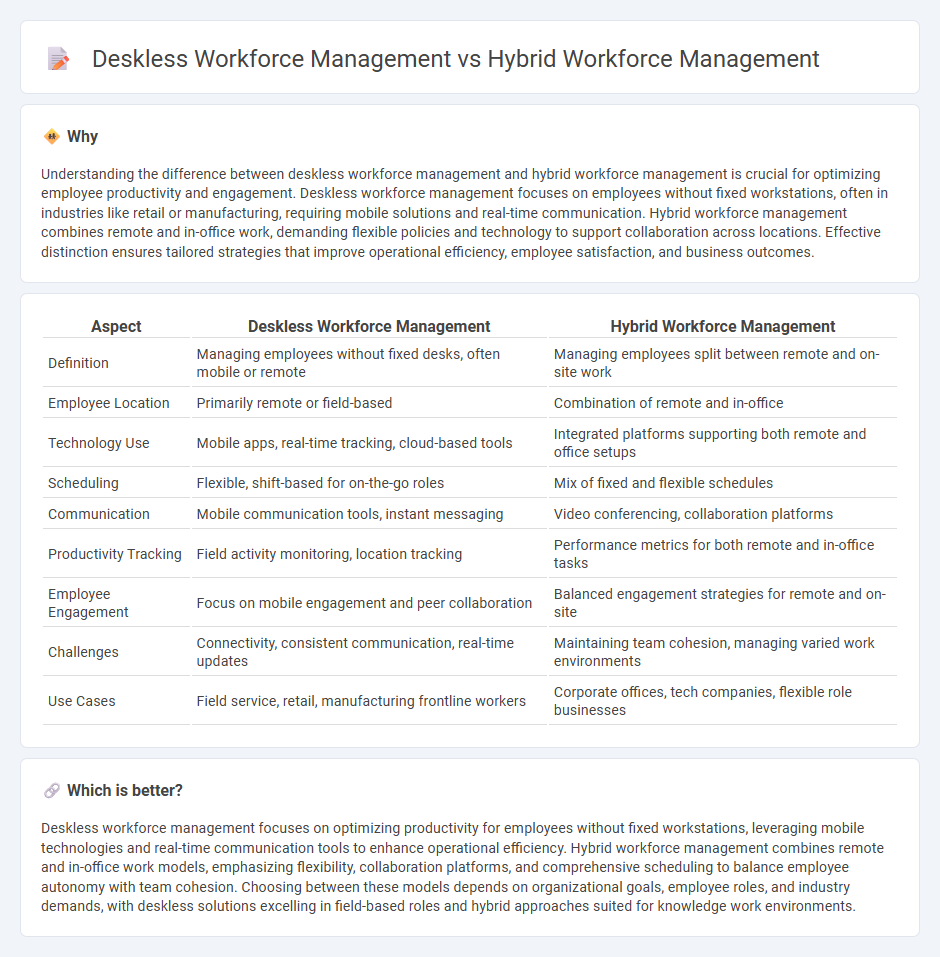
Deskless workforce management focuses on optimizing operations for employees working in the field, retail, or on-site without fixed desks, utilizing mobile technology to enhance communication and task tracking. Hybrid workforce management combines remote and on-site employee coordination, leveraging digital tools to balance flexibility, productivity, and collaboration across diverse work environments. Explore how these workforce management strategies can transform productivity and employee engagement in your organization.
Why it is important
Understanding the difference between deskless workforce management and hybrid workforce management is crucial for optimizing employee productivity and engagement. Deskless workforce management focuses on employees without fixed workstations, often in industries like retail or manufacturing, requiring mobile solutions and real-time communication. Hybrid workforce management combines remote and in-office work, demanding flexible policies and technology to support collaboration across locations. Effective distinction ensures tailored strategies that improve operational efficiency, employee satisfaction, and business outcomes.
Comparison Table
| Aspect | Deskless Workforce Management | Hybrid Workforce Management |
|---|---|---|
| Definition | Managing employees without fixed desks, often mobile or remote | Managing employees split between remote and on-site work |
| Employee Location | Primarily remote or field-based | Combination of remote and in-office |
| Technology Use | Mobile apps, real-time tracking, cloud-based tools | Integrated platforms supporting both remote and office setups |
| Scheduling | Flexible, shift-based for on-the-go roles | Mix of fixed and flexible schedules |
| Communication | Mobile communication tools, instant messaging | Video conferencing, collaboration platforms |
| Productivity Tracking | Field activity monitoring, location tracking | Performance metrics for both remote and in-office tasks |
| Employee Engagement | Focus on mobile engagement and peer collaboration | Balanced engagement strategies for remote and on-site |
| Challenges | Connectivity, consistent communication, real-time updates | Maintaining team cohesion, managing varied work environments |
| Use Cases | Field service, retail, manufacturing frontline workers | Corporate offices, tech companies, flexible role businesses |
Which is better?
Deskless workforce management focuses on optimizing productivity for employees without fixed workstations, leveraging mobile technologies and real-time communication tools to enhance operational efficiency. Hybrid workforce management combines remote and in-office work models, emphasizing flexibility, collaboration platforms, and comprehensive scheduling to balance employee autonomy with team cohesion. Choosing between these models depends on organizational goals, employee roles, and industry demands, with deskless solutions excelling in field-based roles and hybrid approaches suited for knowledge work environments.
Connection
Deskless workforce management and hybrid workforce management are interconnected through their focus on optimizing employee productivity and engagement across various work environments. Both approaches leverage digital tools and mobile technologies to enable seamless communication, task tracking, and scheduling for employees who operate outside traditional office settings. Integrating these management strategies allows organizations to effectively coordinate on-site, remote, and mobile workers, enhancing operational efficiency and workforce flexibility.
Key Terms
Flexibility Policies
Hybrid workforce management emphasizes flexible scheduling and remote work options to enhance employee autonomy and productivity, while deskless workforce management prioritizes mobile access, real-time communication, and location-independent task execution. Flexibility policies in hybrid models often include hybrid hours, remote work allowances, and adaptable office presence, whereas deskless policies focus on shift flexibility, role adaptability, and operational continuity across various physical sites. Explore comprehensive strategies to optimize flexibility policies for both workforce types and drive organizational efficiency.
Technology Enablement
Hybrid workforce management integrates digital tools like cloud platforms and collaboration software to seamlessly support employees working both remotely and on-site. Deskless workforce management relies heavily on mobile applications, real-time data analytics, and IoT devices to enhance productivity and communication for field and frontline workers without fixed workstations. Explore how cutting-edge technology enablement transforms operational efficiency in both workforce models.
Employee Engagement
Hybrid workforce management enhances employee engagement by offering flexibility and autonomy, allowing remote and on-site workers to collaborate seamlessly. Deskless workforce management focuses on real-time communication and task management for mobile employees, boosting engagement through streamlined operations and accessible technology. Discover how tailored strategies in each model can elevate employee satisfaction and productivity.
Source and External Links
12 Factors To Consider When Managing A Hybrid Workforce - A hybrid workforce blends remote and office work, enabling flexibility, access to a global talent pool, and cost-effective scaling, with a focus on equipping employees with skills for remote work.
What is a Hybrid Workforce? Benefits, Best practices and Solutions - Managing a hybrid workforce requires clear communication, investing in proper technology and equipment, and fostering employee well-being and productivity in both remote and office settings.
6 Best Practices for Hybrid Workforce Management - Key practices include documenting clear hybrid work policies, defining productivity metrics, providing technology support, and balancing virtual and in-person collaboration effectively.
 dowidth.com
dowidth.com